Zombies in the Real Life Essay
Today, the public discuss zombies as part of the popular culture, although during the decades, these creatures were associated only with frightening religious practices typical for the African and Caribbean cultures and traditions. That is why, now zombies are the topic for the active discussion in different cultural, social, and religious fields. If the persons interested in horror films and video games discuss zombies as made-up creatures, the followers of the Voodoo religion state that zombies are the part of their reality as witches and different evil spirits. Thus, although the concept of ‘zombie’ is discussed by the adherents of the Voodoo religion as reflecting the real creatures, zombies are made up mythical creatures which represent the people’s religious visions, fears of the death and abuse, and the aspects of the people’s opinion on such a type of social relations as slavery.
Zombies are usually defined as the revived corpses which move and act because of the use of magical means. Following the traditional presentation of zombies in films and video games, it is possible to note that “zombies do not think or speak – they simply act, relying on purely physical manifestations of terror” (Bishop 197). As a result, modern filmmakers rely on the concept of ‘zombie’ to create an effective horror film to evoke the audience’s fears. Today, zombies, as made-up creatures, play a significant role in the popular culture, and the history of the word ‘zombie’ can demonstrate the development of the people’s attitude to the concept. The word ‘zombie’ comes from the Kimbundu term meaning ‘the ghost,’ and it appears in the Creole language with the spread of the slave trade. In this case, the word ‘zombie’ means the mindless labor force (Bishop 197). The modern connotations of the word ‘zombie’ are numerous because this concept is used to discuss the part of the Voodoo religion, the monsters depicted in the media, and the tired persons who act automatically. Thus, the word ‘zombie’ does not reflect the real creatures which eat humans, but this made-up concept describes the set of features typical for mindless and ill persons as well as for slaves.
From this point, the concept of ‘zombie’ has changed significantly because modern meanings of the word have few similarities with the traditional visions. The word ‘zombie’ became actively used in the 18th century to represent the slaves and the nature of the power relations in the Haitian culture (Murphy 53). Furthermore, the word described the spirits of dead persons who could act as slaves after the revival of their corpses as a result of the Voodoo priests’ actions. The myth of zombies based on the idea of the mindless slavery formed quickly, and more details were added to this vision. For instance, in the Haitian myth, a zombie was “a person bodily raised from the grave and turned into a slave worker” (McAlister 459).
As a slave worker, a zombie had few chances to become free. Thus, “the zombie breaks the master’s spell when it ingests salt and can die, once again, but this time free” (Murphy 53). In other situations, zombies as the revived corpses remain to be traumatized and mindless creatures punished for leaving their owners. If the myth of zombies contributed to the development of slavery and power relations in the Haitian culture two centuries ago, today this myth is revised and presented in the horror films in the form of the cannibalistic walking dead.
Modern zombies are only the symbolic representations of the people’s fears of dead persons, corpses, and spirits. Literature cannot be discussed as the source of information about zombies because of their nature, and the public develops its knowledge of zombies mainly referring to films and video games because the visual media develop the zombie idea more effectively. The zombie depicted in films is the mystical walking dead, the monster which eats people and can be controlled only with the help of magical means (Bishop 197). Thus, modern zombies as the symbolic structures developed from the Voodoo religious vision are not real, but they are the reflections of powerful myths manipulating the people’s fears. From this perspective, a zombie today is “a ghoul who lumbers around trying to eat people” (McAlister 460).
George Romero focused on depicting zombies in his films in the 1960s, and the era of ‘zombification’ started. More zombie films are produced each decade, and the popularity of this theme in films even influenced literature, and the parody novel Pride and Prejudice and Zombies became the bestseller (McAlister 460). Today, ‘zombie’ is the popular concept actively used in different types of zombie-themed images and captions spread in the media, including social networks and newspapers. Thus, focusing on zombies, filmmakers, and journalists follow the trend, but these zombies are only symbolic images to represent the cannibalistic corpses.
However, many researchers support the idea that zombies are real because, in the Haitian culture and Voodoo religion, priests can use different substances to make people become zombies. Thus, according to these views, zombification can be discussed as the result of pharmacology and the Voodoo priests’ use of powerful neurotoxins (Bishop 197). Nevertheless, the experiments and surveys cannot prove the presented hypotheses, and the secret of the Haitian zombies remains to be unsolved. People are inclined to focus more on the promotion of the traditional vision of zombies used in the horror films, and these zombies are only symbolic monsters and mystical images which differ significantly from the original vision of zombies as slaves. From this point, the concept of ‘zombie’ traditionally reflects the unequal nature of the slavery institution with references to the mystical explanations. As a result, zombies are only part of the cultural and religious myth.
Although the idea of zombies is actively manipulated in the Haitian culture, zombies are real only in people’s fantasies and myths. That is why, the made-up zombies depicted in films and video games are not associated with the Haitian culture, and only the followers of the Voodoo religion are fearful of being punished for becoming a zombie. Nevertheless, researchers cannot provide reliable evidence to prove the fact that people can be turned in zombies. That is why zombies can be discussed only as of the products of the human minds and imagination, which became popular because of their intriguing nature. From this point, the notion of ‘zombie’ is usually not discussed as reflecting the real creature because of the idea’s complex mystical and symbolic nature. Thus, modern zombies are only monsters depicted in visual media.

Works Cited
Bishop, Kyle. “Raising the Dead”. Journal of Popular Film and Television 33.4 (2006): 196-205. Print.
McAlister, Elizabeth. “Slaves, Cannibals, and Infected Hyper-Whites: The Race and Religion of Zombies”. Anthropological Quarterly 85.2 (2012): 457–486. Print.
Murphy, Kieran. “White Zombie”. Contemporary French and Francophone Studies 15.1 (2011): 47-55. Print.
- Misperceptions of the Voodoo Religion
- Voodoo: Is It a Fact or Fiction?
- "World War Z" a Book by Max Brooks
- Okonkwo's Identity in "Things Fall Apart"
- Identity in "Things Fall Apart" by Chinua Achebe
- Literary Genre of Existentialist Novel
- The Most Realistic Character in "The Iliad" by Homer
- The Archetype of Sacrifice in Literature
- Chicago (A-D)
- Chicago (N-B)
IvyPanda. (2020, May 12). Zombies in the Real Life. https://ivypanda.com/essays/zombies-in-the-real-life/
"Zombies in the Real Life." IvyPanda , 12 May 2020, ivypanda.com/essays/zombies-in-the-real-life/.
IvyPanda . (2020) 'Zombies in the Real Life'. 12 May.
IvyPanda . 2020. "Zombies in the Real Life." May 12, 2020. https://ivypanda.com/essays/zombies-in-the-real-life/.
1. IvyPanda . "Zombies in the Real Life." May 12, 2020. https://ivypanda.com/essays/zombies-in-the-real-life/.
Bibliography
IvyPanda . "Zombies in the Real Life." May 12, 2020. https://ivypanda.com/essays/zombies-in-the-real-life/.
Zombies and our Culture
How it works
In trying to understand the influence zombies have on the society, it is relevant to know the origin of zombies. The first mention of zombie was in Haiti to represent the returned body. Then films began creating this monsters, and one thing led to another. The word monster can be defined as fear taking a physical form. The society makes a physical form of something that is perceived to cause concern. Zombies, Vampires and even Godzilla’s are all created due to the common fear of something.
The culture creates an obsession with a type of fear, and it is brought to life. Different forms of similar monsters exist this indicates that people have various kinds of obsessions. The modern-day zombies have a different outlook from the past zombies. The manner in which zombies have become popular goes to indicate the level of passion that our culture has with these monsters (Do Vale, 191).
The purpose of this paper is to try and understand zombies in general, reasons for their popularity and what they represent in our culture. These monsters symbolize shared cultural fear. In observing many films about zombies, they mostly result from scientific experiments and technological catastrophes. This fascination represents the fear we have from the technical progress that the social experiences with the fast-paced technological advances (Sills, n.p). Most of the zombie movies are set in a way that represents a massive catastrophe. The zombie effect is expected to be a global event. The fear of ecological disasters, large-scale nuclear wipeouts, artificial viruses just to name a few. Zombies could be a way that the society tries to show what they fear most. The cultural phenomena addressed by Albert Einstein that technology advances would come around and be the end of humanity also plays a role in these monster creations.
Furthermore, the zombie obsession goes beyond just fear of zombies harming the society physically. It can be more about what technology and capitalism can do to the society mentally (Do Vale, 191). This goes to explain the process of becoming zombies differ in the modern era to the earlier days. Back then these monsters were created from voodoo or black magic. These were in most countries that practiced magic like West Africa and the Caribbean. Now zombies are set up in technological settings. The zombie obsession could be used to show how the society fears what technology does to them. Technology limits the human use of their abilities and becomes brain dead, just like zombies. This goes to represent human fear of technology destroying the society mentally.
The fear of consumerism. The society is afraid that consumerism is replacing our humanity (Harper, n.p). The zombies are a real representation of consumerism. These monsters are driven by the need to feed. Zombies are entirely monsters because of their insatiable appetite according to Harper. They just want to consume. Likewise, humans too when driven by consumerism become zombies in some sense. For instance black Friday shoppers. How many people do you witness getting trampled upon by others in the process of getting goodies? The human desire to consume is metaphorically represented by zombies.
That this desire may go as far as turning people into zombie-like if consumerism takes over. Zombies also represent the fear of terrorism. The setting of most zombie films is a contamination infects people, spreads, governments fall, and people turn against each other leading to the world ending. Post 9/11 signified the change of the general zombie outlook (Conrad, n.p). Before those zombies were cartoonish but after that, they took a more human-like form. They conform to become strategic and smart. This new monster signified the fear that people of the United States had, they represented fear coming from outside (Sills, n.p). Terrorism also represents infected individuals and how if not noticed early the world might get wiped out. Metaphorically zombies account for the decay of social order that might result from terrorism. This is one of the many fears that zombies represent in our culture.
Nonetheless, another reason that the society produces these monsters could be the desire to channel excess stress by all means. Fascination about zombies becomes a way to mass subconscious channels out societal problems related to life stress (Conrad, n.p). It is like that the reason why our culture is fascinated if not thrilled by zombie idea is that in the society observe and adopt things that are taken for granted or those issues that are not disputed. The popularity of zombies shows just how much the culture shares common morals and values.
In conclusion, monsters over the last decade have been created more in the popular culture. Monsters like vampires have been on the trend for a long while. However, the zombie effect has become more popular due to them signifying the end of the world. The reasons for this popularity remains open, and many reasons have been brought up in the attempt to explain it. The simplicity in zombies make the society associate zombies with anything they want. This makes understanding what zombies represent to be a difficult task. What remains for sure is that zombies represent our fears. Fear of many things ranging from technology, terrorism to science. In general, zombies account for the end of the world as the most feared anticipated event.
Works cited
Conrad, Peter. Zombies: A Cultural History Review“ a Grave Injustice. The Observer, Guardian News and Media, 17 Aug. 2015, www.theguardian.com/books/2015/aug/17/zombies-a-cultural-history-roger-luckhurst-review.
Do Vale, Simone. “Trash mob: Zombie walks and the positivity of monsters in western popular culture.” At the Interface/Probing the Boundaries 70 (2010): 191-202.
Harper, Stephen. “Zombies, malls, and the consumerism debate: George Romero’s Dawn of the Dead.” Americana: The Journal of American Popular Culture, 1900 to Present 1.2 (2002).
Sills, Davia. What Does the Zombie Say about Who We Are and What We Fear? “ Davia Sills | Aeon Essays. Aeon, Aeon, 26 Sept. 2017, https://aeon.co/essays/what-does-the-zombie-say-about-who-we-are-and-what-we-fear
Cite this page
Zombies and our culture. (2019, Dec 30). Retrieved from https://papersowl.com/examples/zombies-and-our-culture/
"Zombies and our culture." PapersOwl.com , 30 Dec 2019, https://papersowl.com/examples/zombies-and-our-culture/
PapersOwl.com. (2019). Zombies and our culture . [Online]. Available at: https://papersowl.com/examples/zombies-and-our-culture/ [Accessed: 24 May. 2024]
"Zombies and our culture." PapersOwl.com, Dec 30, 2019. Accessed May 24, 2024. https://papersowl.com/examples/zombies-and-our-culture/
"Zombies and our culture," PapersOwl.com , 30-Dec-2019. [Online]. Available: https://papersowl.com/examples/zombies-and-our-culture/. [Accessed: 24-May-2024]
PapersOwl.com. (2019). Zombies and our culture . [Online]. Available at: https://papersowl.com/examples/zombies-and-our-culture/ [Accessed: 24-May-2024]
Don't let plagiarism ruin your grade
Hire a writer to get a unique paper crafted to your needs.

Our writers will help you fix any mistakes and get an A+!
Please check your inbox.
You can order an original essay written according to your instructions.
Trusted by over 1 million students worldwide
1. Tell Us Your Requirements
2. Pick your perfect writer
3. Get Your Paper and Pay
Hi! I'm Amy, your personal assistant!
Don't know where to start? Give me your paper requirements and I connect you to an academic expert.
short deadlines
100% Plagiarism-Free
Certified writers
May 22, 2024
Cooperation Is the Key to Surviving the Apocalypse
Cooperation theorist Athena Aktipis talks about zombies, game theory, go bags and more in her new book, A Field Guide to the Apocalypse .
By Rachel Feltman & Anaissa Ruiz Tejada
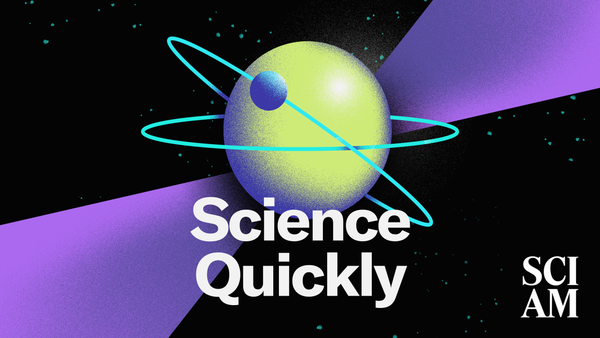
Anaissa Ruiz Tejada/ Scientific American

[CLIP: Theme music]
Rachel Feltman: Picture someone who’s prepared to survive the end of the world: What are they up to? Maybe you’re imagining a “vaultie” from Fallout zipping themselves into a uniform and heading underground to hide away from the rest of humanity. Or did your mind jump to Nick Offerman’s isolationist tactics in the The Last of Us ? Sorry, I gotta move on from that one very quick or I will start crying.
According to Athena Aktipis , an associate professor in the Department of Psychology at Arizona State University, the folks most likely to survive and thrive in the wake of catastrophe would do a lot less hiding—and maybe a lot more goofing around.
On supporting science journalism
If you're enjoying this article, consider supporting our award-winning journalism by subscribing . By purchasing a subscription you are helping to ensure the future of impactful stories about the discoveries and ideas shaping our world today.
So get in, loser! We’re getting ready for the apocalypse.
For Science Quickly , I’m Rachel Feltman.
Feltman: Athena, thanks for coming on. I’m really excited to talk to you about your latest book.
Athena Aktipis: Yeah, so my book is called A Field Guide to the Apocalypse: A Mostly Serious Guide to Surviving Our Wild Times. And it is, in a nutshell, a fun book about how to survive the apocalypse.
Feltman: Listeners might be surprised to learn that a funny book about the apocalypse is like a pretty natural progression of your research on cooperation, which you’ve managed to apply to everything from cells to zombie outbreaks. How did you get into such interdisciplinary and zombified work?
Aktipis: Well, okay, to be perfectly honest, all of this started when I was an extremely nerdy teenager because I would go and hang out in my local bookstore and just like read all the books, and I was like, “I want to understand how everything works.” And then also I was like, “Things in the world don’t seem quite right.” So I was kind of coming of age in the 1990s, in the late 1990s, and I was like, “Maybe this isn’t sustainable. Maybe we can’t keep doing things the way we have been forever.” And I very much became an environmentalist as a teen. But I was also just fascinated by human nature and trying to, like, just really understand how it is that we are the way we are and especially using evolutionary biology as a tool to understand human nature.
And actually, I know this sounds kind of crazy, but, like, I made a conscious decision when I went into college that I would go all academic to learn as much as I could about all the things that are relevant to human nature for dealing with the problems in the world. And then I was like, “And then at some point in my life, I’ll turn to pulling it all together to try to, like, do something about all of this.”
And lo and behold, here I am now, two decades later, and I have this book that probably my 17-year-old self would be really, really happy that I wrote.
Feltman: Awesome—well, and you mentioned this is, like, a pretty lighthearted book about the apocalypse. What informed your approach? Because this is definitely unique in the world of apocalyptic nonfiction.
Aktipis: Well, it’s a weird book in that, on one hand, it’s, like, lighthearted and funny; I had somebody call it a beach read the other day.
But it’s also just chock-full of information about how our brains work, about how we process information when we’re under stress, about how humans deal with strategic situations when there’s conflict and how we solve, like, collective-action dilemmas.
There just isn’t another book like that. Like, most books that are about existential risk are boring and terrifying at the same time. And so I didn’t want to write a book like that—definitely not.
Feltman: Yeah, I don’t think anyone could accuse you of being boring—I mean, you literally run a conference about zombies. So why do you think it is that playfulness can help us prepare for hard times?
Aktipis: I think one of the big challenges now for a lot of people is that there are a lot of things that are scary, not fun, that we know we have to deal with.
But it can be really hard to engage with them when we have all these other things going on.
And so these sort of, like, cycles of anxiety and fear and doom-scrolling and—you know, you’re just, like, getting all this information, and then you’re just like, “Oh, my brain’s gonna explode, and I need a nap.”
But the thing is, we have a lot of other emotions that we can leverage for dealing with crises. And this is something that humans do around the world when there are crises: there are all of these positive sides of human nature and positive aspects of human experience that come out.
So, you know, cooperation—for one thing, like, during times of need people help each other. It’s actually a huge focus of the book. But also using storytelling, using humor, creating sort of shared attention around the threats, but in a way that invites imagination, creativity, playfulness—that puts us in a mindset where we deal more effectively with problems because our brains are more open; we’re not, like, shut down in fear mode.
And so a lot of what I’ve tried to do with the book is not just make the book itself fun but also describe how we do need to leverage these positive sides of human nature and how we experience the world to engage with the things in, you know, our future and our present that are most scary. And people like to do it—I mean, people, like, for fun, watch horror movies. It’s part of our nature to be morbidly curious, and it’s just a matter of connecting all the dots to get us somewhere productive in terms of dealing with the challenges in the world.
Feltman: That makes so much sense. What are some examples of communities where we can actually see some of that positivity?
Aktipis: Yeah, so I’m the co-director of this project called the Human Generosity Project, where we’ve looked at how people help each other in times of need. We’ve done field work in more than a dozen small-scale societies around the world, computational models and then also experiments with human participants. And what we found is that people help each other in times of need and that in the computational models, this is a viable strategy that can outperform strategies that are more, like, stingy and, like, account-keeping.
My favorite example from the field is really where the whole project started, which is with the osotua rules that the Maasai of East Africa follow. Osotua is a very important part of their culture and how they relate to one another.
They depend on their herds of cattle for their survival, and so if there’s a drought or disease, somebody might lose cattle through no fault of their own. And then they can ask an osotua partner for cattle to get up to the threshold for what they need to support themselves and their family, and people will give without expecting to get paid back. It’s almost like an informal insurance system.
And we see examples of this in other societies, many other societies.
Even in the American West, there’s a system called neighboring, where neighbors will help each other in times of need, and one really interesting tidbit from this work that we did in the West—so this is in southern Arizona and New Mexico, near the border—the ranches that are, you know, huge, and people’s neighbors are, you know, a half hour away, often, but they will drive long distances to help one another. And if the help is because of something that was unexpected, like somebody gets injured or is sick, they help each other without expecting to get paid back—versus things that are more predictable, when they sort of expect, “Oh, like, if I go and help you with branding, then you’ll come and help me with branding because that’s more of a predictable thing.”
We actually then replicated this with an online sample of people who are more urban and found the same pattern, where the needs that arise unpredictably, people help without expecting to get paid back.
It really seems like what’s going on is that a sort of fundamental aspect of human social behavior, human cooperation, is really tuned in to providing a safety net for each other when disasters occur, when there’s crises, when there’s catastrophes that are outside of your control.
Feltman: And so for folks who are like, “That sounds great. That’s how I want to live. What do I do to build a community like that?” What do you tell folks who are like, “But we live in a society,” in other words?
Aktipis: Yes, and if you think about it, you probably already have friends that you would call upon in a time of need, who would be there for you and not expect you to pay them back for it.
That might not be most of the people in your social world, but if you have, you know, a few people who you’re close to who play that role, then you actually are already embedded in a need-based transfer network.
Now, you might not be explicit about it like the Maasai are, right, like, calling it this sort of special thing. But I would say that all—or definitely most—of us already have some of that.
If you can be more explicit about it, then that can, you know, both help you to, like, be conscious about cultivating that and also help just you feel, like, maybe a little better and more secure on a day-to-day basis, like, “Oh, yeah, I’ve got people who’ve got my back.”
We can all do that. We can all start there, with the networks we have: strengthen them, grow them. And that can happen, you know, within a society where the norms of transactions are based mostly on market principles. We can grow those networks of mutual aid just on the basis of mutually deciding that we want to be there for each other.
Feltman: What would you say is the most important lesson for people to take from your book?
Aktipis: Well, I would start with the cooperation piece. I mean, I think for many people, when they think of the apocalypse, they think of the breakdown of society and everyone for themselves, and, you know, how are you going to deal with the conflict and everybody trying to steal things from each other, right? And that’s kind of the image that often pops into people’s heads.
You know, there’s certainly a lot of apocalyptic fiction that, like, you know, shows that kind of world, too, so that probably at least contributes to our, you know, imaginations often going there, and also, you know, I mean, people like to imagine and think through worst-case scenarios, partially for entertainment value but also because it’s, like, practice for if things do get really bad, and that kind of makes sense.
But in reality what we see when there are disasters, whether we’re looking at small-scale societies or we’re looking at historical examples like the 1906 earthquake in San Francisco or more modern examples like Hurricane Katrina and many of the storms that we’ve had in the Gulf Coast region recently, people help each other. Yeah, maybe there are a few bad actors in there that are trying to take advantage of the chaos, but that is the exception.
In general, like, people go into a very generous mode, where they’re helping each other, they’re building social connections, they’re looking for what needs to happen for everybody to be taken care of and jumping in and doing it. Based on what we know about how humans respond, that is absolutely the more likely scenario in any sort of apocalypse.
And also, if you expect that it’s going to be everyone just being selfish and horrible to one another, then you can actually create a self-fulfilling prophecy because you’re not going to be going in with that attitude of cooperation, and you then might make yourself a threat to the people who are wanting to cooperate.
So I talk about some of, like, the game theory underlying that and how, by understanding the strategic landscape of how, like, as humans we adapt to our expectations about what others are going to do, that, that is a really important piece of kind of figuring out how you should handle things when your environment changes a lot.
Feltman: Okay, so you’ve convinced us all to read your book, but I’ve heard you’re also taking your message on tour. Tell us more about The Apocalypse Road Show .
Aktipis: Yeah, so The Apocalypse Road Show is kind of, like, half a book tour for A Field Guide to the Apocalypse and half just, like, a really, really fun opportunity to go on the road with colleagues and friends and musicians to bring a hopeful message of how we can all survive the apocalypse.
A lot of what we’re doing with the road show is kind of enacting the principles from the book.
You know, as humans, like, we’re really fundamentally social, and we deal with many problems as a collective, and we’re really good at that when we can communicate effectively, when we trust each other, when we can cooperate.
But that doesn’t just come out of nowhere, right? Like, you have to create space for it. And so that’s a lot of what we’re doing with The Apocalypse Road Show , and if you want to learn more about it, you can go to ApocalypseRoadShow.com, and we have all our dates up there and everything, and then we’re posting a bunch of fun content on Instagram, so you can see some of the things that we’ve already done with our shows there and where we’re going in the future.
Feltman: Well—and I have to ask you: what’s in your go bag these days? Or do you have multiple go bags?
Aktipis: There’s a lot of misconceptions about prepping and preppers and all of that, and I always try to be, like, “Being prepared for disasters is just something that we should all do.” Even if you don’t have a go bag, you should have a shelter-in-place kit so that if you have a disaster where you have to stay home, you have what you need to survive for 72 hours.
And I like to tell people, like, “Actually start with that—it’s easy.” And if another pandemic happens, you’ll be fine because you can just stay home, and you also don’t need to put strain on the infrastructure that is there to help deal with the acute crisis.
Feltman: Right, you’ve already got your toilet paper; you’re good to go.
Aktipis: You have your toilet paper—exactly. Make sure you have your toilet paper.
So, yeah, in my go bag, I have a lot of stuff, honestly, but I focus on having an emergency blanket; water or a, like, LifeStraw so you can clean water; matches, a lighter, et cetera; and some food. And then you work from there, you know, with local maps. You have some things for fun, like some cards or a harmonica. You can go to Ready.gov—they have all of that on there, too—but I have a bunch of pages in my book that explain all of the things with pictures: what you need and extras that you might want.
My favorite part of, like, being prepared is my car kit, and I use that all the time. Sometimes I’m driving, and maybe it’s not even a big crisis, but maybe somebody gets a cut, and then it’s like, “Oh, I’ve got Band-Aids in my trunk.” You know, it’s, like, nice to be able to be prepared like that. And then I also have, like, a little adventure everyday-carry that I take with me when I go hiking or kayaking or, you know, somewhere where the unexpected might happen, and I use that all the time.
And for me, there really is this sort of continuity of, like, having a sense of adventure and being willing to, like, take some risks in terms of, like, going out into the world and exploring—I know that I have my everyday-carry adventure kit, so for the routine kinds of things that might go wrong, I’m ready. And I like to think, like, we can take that kind of energy, that, like, sense of adventure and being, like, “You know what, like, I’ve got my go bag and my shelter-in-place kit, so, like, I don’t have to be as scared in this world.”
Feltman: That’s all for today, folks. We’ll be back on Friday with the next segment of our ongoing series about Cape Cod’s insidious “yellow tide.”
Science Quickly is produced by me, Rachel Feltman, along with Kelso Harper, Carin Leong, Madison Goldberg and Jeff DelViscio.
Elah Feder, Alexa Lim, Madison Goldberg and Anaissa Ruiz Tejada edit our show, with fact-checking from Shayna Posses and Aaron Shattuck.
Our theme music was composed by Dominic Smith. Subscribe to Scientific American for more up-to-date and in-depth science news.
Do you have an idea for a story we should cover or some feedback about our new episode formats? Give us a shout at [email protected] .
For Science Quickly , I’m Rachel Feltman. See you next time!
Academia.edu no longer supports Internet Explorer.
To browse Academia.edu and the wider internet faster and more securely, please take a few seconds to upgrade your browser .
Enter the email address you signed up with and we'll email you a reset link.
- We're Hiring!
- Help Center

Zombie thesis

Related Papers
Sara McCabe
Special Issue, Vol.XV No.6 2012
Nur Ozgenalp
In this work, my aim is to analyze zombie films in relation to capitalism. 1970’s horror films, especially zombie films were reflecting the economical, political and social structure of its era; however, the characteristics of zombie films have changed through time. Primarily, I will compare George A. Romero’s zombie film, Dawn of the Dead (Romero, 1978) from 1970s which is famous with its commentary on commodity fetishism and consumption society. Then, in its light, I will investigate Resident Evil Series of 2000s to explore the codes of contemporary zombie films and understand what has changed through time in comprehension of zombie metaphors. My analysis will be on all Resident Evil films, but I will especially focus on the first film, Resident Evil (Anderson, 2002), and the third film, Resident Evil: Extinction (Mulcahy, 2007), to examine new threat themes, such as bio-technological and viral weaponry, used to represent the contemporary political and financial influences of capitalism globally. Keywords: zombie narratives, contemporary capitalism, consumption society.
Heather Myers
Victoria Carrington
Final Draft - chapter for Generation Z: Zombies, Popular Culture, and Educating Youth (forthcoming). Victoria Carrington, Esther Priyadharshini, Jennifer Rowsell and Rebecca Westrup (Eds).
Tyll Zybura
Extensive collection of scholarly research on zombies in popular culture. • Updated: 14 September 2016 • BibTeX: <http://www.zybura.de/ZombieStudiesBibliography.bib>. Most up-to-date online version: <https://www.zotero.org/groups/zombie_studies_bibliography/items>.
Carla Gonzalez
Visioni Dell'Apocalisse
Zara Zimbardo
Jonathan Mejias
Sociology Compass
Todd Platts
In this essay, focusing primarily on the cinema of the walking corpse, I provide an overview of zombie studies and suggest potential avenues for sociological inquiry into zombie phenomena. I argue that zombie films, comic books, novels, video games, and the like can be seen as significant cultural objects that reflect and reveal the cultural and material circumstances of their creation. Despite emanating from complex culture producing institutions and (arguably) capturing extant social anxieties, sociology has remained quiet on zombie phenomena. Issues of significance, history, and definition are discussed. I then locate three avenues of inquiry ideally suited to the sociological toolkit: symptomatic analysis of content, production, and audience response and interaction. I conclude by calling for a multi-pronged sociological analysis into ‘zombie culture.’
RELATED PAPERS
Evelyn N Hunston
Jordan Carroll
Textes & Contextes 6
David Roche
Scott Lukas
Phoebe Rudolph
RELATED TOPICS
- We're Hiring!
- Help Center
- Find new research papers in:
- Health Sciences
- Earth Sciences
- Cognitive Science
- Mathematics
- Computer Science
- Academia ©2024
We use cookies to enhance our website for you. Proceed if you agree to this policy or learn more about it.
- Essay Database >
- Essay Examples >
- Essays Topics >
- Essay on Vampire
Why Zombies And Vampires Exist Argumentative Essay Examples
Type of paper: Argumentative Essay
Topic: Vampire , Blood , Heart , Zombie , Death , Belief , Europe , Literature
Words: 1100
Published: 03/09/2020
ORDER PAPER LIKE THIS
Vampires - in the lower mythology of Europe dead at night getting up from the grave or being in the shape of a bat, sucking the blood of sleeping people, Sender nightmares. Vampires are "unclean" dead - criminals, suicides, deaths of premature death and the dead from the bites of vampires. The image of a vampire is not rare for the cinema and literature, although vampires from works of art, usually, have some differences from the vampire mythology. In folklore, the term, usually, used to refer to the blood-sucking essence of Eastern European legends, but often referred to as vampires and similar creatures from other countries and cultures. It seems that until the XIX century, vampires in Europe were described as horrible monsters from the grave. Vampires, usually, became suicidal, criminals or evil sorcerers, though in some cases become a vampire "offspring of sin" could pass his vampirism on innocent victims. However, sometimes it can become a vampire and victim of a brutal, untimely or violent death. Most Romanian belief in vampires (except Strigoi) and European vampire stories have, according to the literature, of Slavic origin. Vampire can be killed by plunging a stake or something silver (bullet, knife) in the heart or burn. In XVIII-XIX centuries rumors about vampires came not only to the ears of the king of England, but also spread to New England, particularly in Rhode Island and Eastern Connecticut. In these areas, there are many documented cases where families dug those who used to enjoy, and removed the corpses of the heart, in the belief that the deceased was a vampire responsible for illness and death in the family (although the word "vampire" was never used to describe him / her). It was believed that the dead of night visits deadly tuberculosis (or "tuberculosis", as it was called in those days) to the members of his family became the cause of the disease the disease. The most famous (and latest recorded) case was a nineteen year old Mercy Brown, who died in the American Exeter in 1892. Her father, who was assisted by a family doctor, pulled her out of the tomb two months after her death. Her heart was cut out and burned to ashes. Record of this case was found among the papers of Bram Stoker, and the story closely resembles the events in his classic novel "Dracula." Belief in vampires still exists. Although some cultures have kept their original belief in the undead, most modern believers are influenced by artistic image of the vampire as he appears in films and literature. In the 1970s, there were rumors (spread by local media) about a vampire preying on the Highgate Cemetery (Highgate Cemetery) in London. Adult vampire hunters in large numbers thronged the cemetery. Among several books describing this case, we can note books Sean Manchester (Sean Manchester), a local resident who is one of the first to suggest the existence of "Highgate Vampire" and who claimed to be expelled and destroyed all the vampire nest in the area. In the modern folklore of Puerto Rico and Mexico, the chupacabra is considered the creation of those that eats flesh or drink the blood of animals. This gives grounds to consider it another kind of vampire. "Hysteria due chupacabra" is often associated with deep economic and political crises, particularly in the mid-1990s. In late 2002 and early 2003, hysteria about the so-called vampire attacks spread throughout the African country of Malawi. The crowd sounded a death with stones and attacked at least another four people, including the governor Chivayya Eric (Eric Chiwaya), based on the belief that the government was colluding with vampires. In Romania, in February 2004, some of the relatives of the late Toma Petre (Toma Petre) feared that he became a vampire. They dragged his corpse, tore his heart, burned it, and mixed the ashes with water, then to drink it.
Zombies are, usually, be understood as supernatural way a human corpse. In today's epic, we also meet zombie animals. Also, zombies can still call a person who does not control their own actions and the body in general. Also, in a figurative sense, zombie people - craze something or someone. The exact origin of the term, as the word itself, is still a lot of rumors and controversy. We only know one thing. Zombies come to us from Africa. Do not get too into the details, and etymology. Zombies appeared in the West Indies, particularly in Haiti, along with the cult of voodoo, brought with them African "guests." Similarity zombies are found not only in the culture of West Africa and the Caribbean. In Japanese mythology, there is the spirit of bosc, who feeds on human flesh. Bosc spirits are the souls of people who died of starvation. The first person to mention in the present context the term "zombie" is considered to be well-known American occultist and explorer William Seabrook (William Seabrook). It happened in 1929 in a book by William "Magic Island," which he wrote after a visit to Haiti, where he met with a voodoo sorcerers. American was generally odious personality and wrote many bestsellers about your experience cannibalism, voodoo, and confinement in a mental hospital. And he died an unnatural death from a drug overdose. The publication was the first impetus to the emergence of interest in the company to a zombie. Within three years after this was filmed the first picture on the theme of zombies - "White Zombie", the events which are taking place in Haiti, where the slave owner controls an army of zombies, engaged in the cultivation of sugar cane on his plantations. The concept of zombies in a context in which we see it now in movies, games and literature, was formed in the late 60-ies of the last century, after the release of pictures of George Romero's "Night of the Living Dead."
Barber, Paul (1988). Vampires, Burial and Death: Folklore and Reality. New York: Yale University Press. ISBN 0-300-04126-8. Bunson, Matthew (1993). The Vampire Encyclopedia. London: Thames & Hudson. ISBN 0-500-27748-6. Black, J. Anderson (2000) The Dead Walk Noir Publishing, Hereford, Herefordshire, ISBN 0-9536564-2-X

Cite this page
Share with friends using:
Removal Request

Finished papers: 1396
This paper is created by writer with
ID 250992546
If you want your paper to be:
Well-researched, fact-checked, and accurate
Original, fresh, based on current data
Eloquently written and immaculately formatted
275 words = 1 page double-spaced

Get your papers done by pros!
Other Pages
Example of course work on gender roles in the taming of the shrew, good course work on ageism and age discrimination, free airline distribution system case study sample, research paper on the farm bill, should florida permit young childrens overnight visits essay samples, example of criticism on the patient protection and affordable care act critical thinking, good example of history of childrens literature course work, patient rights versus the practical needs of the medical community essays examples, good obsessive compulsive disorder essay example, free creative writing about logistics and distribution exam, free case study on h m choosing between global and regional free trade, paper due date research paper example, example of thesis proposal on wwii american baseball and football, trade offs in unions essay samples, good example of ro bottled water consumption course work, a will essay, the khojaly massacre research paper examples, western civilization essay 2, free essay about oligopoly, good example of case study on activities wal mart should pursue when entering and operating in new markets, essay on according to the most recent research next points should be put on the list of the pragmatic purposes of schools, dorothea essays, dann essays, calcifications essays, duret essays, amassing essays, counterbalancing essays, arterioles essays, betraying essays, baldacchino essays, cassettes essays, conservations essays, squamous cell carcinoma essays, squamous cell essays, music videos essays, quirk essays, handmaid essays, brockenbrough essays, punching essays, kicking essays, wheaton essays, runaways essays, yamashita essays.
Password recovery email has been sent to [email protected]
Use your new password to log in
You are not register!
By clicking Register, you agree to our Terms of Service and that you have read our Privacy Policy .
Now you can download documents directly to your device!
Check your email! An email with your password has already been sent to you! Now you can download documents directly to your device.
or Use the QR code to Save this Paper to Your Phone
The sample is NOT original!
Short on a deadline?
Don't waste time. Get help with 11% off using code - GETWOWED
No, thanks! I'm fine with missing my deadline

Santa Clarita Valley's #1 Local News Source
How to develop a strong thesis statement for your academic paper, sponsored post.
- May 23, 2024
Introduction
In the realm of scholastic writing, a thesis statement operates as the linchpin of your paper, offering a clear and succinct summary of the main argument or position you will have. Crafting a strong thesis declaration is necessary for directing the instructions of your paper, informing your readers about the focus and scope of your argument, and laying the structure for a coherent and convincing piece of composing. In this short post, we will explore the treatment of developing a strong thesis statement, from identifying your subject and performing background research study to examining the strength of your thesis declaration and including it into your paper effectively. For those who require expert assistance in crafting a compelling thesis statement, services like “ write my paper ” can offer invaluable support in refining and perfecting your academic work.
Comprehending the Function of a Thesis Declaration
Before diving into the specifics of crafting a strong thesis statement, it is necessary to comprehend its function and significance in scholastic writing. A thesis statement is a single sentence that encapsulates the main argument or essence of your paper. It supplies a roadmap for your readers, explaining the scope of your argument and revealing the instructions your paper will take. A well-crafted thesis declaration not only notifies your readers about the function of your paper however likewise helps you remain focused and organized as you establish your argument.
Acknowledging the Topic and Scope
The first step in establishing a strong thesis declaration is to acknowledge your topic and define the scope of your paper. Your subject should specify adequate to be workable within the restraints of your job however broad enough to allow significant expedition. Spend some time to conceptualize possible subjects and consider their significance, significance, and efficiency. When you have chosen a topic, narrow it down to a specific aspect or concern that you can successfully check out in your paper. Specifying the scope of your paper will help you remain concentrated and assurance that your thesis declaration stays clear and succinct.
Performing Background Research
Once you have determined your topic and specified the scope of your paper, the next step is to perform background research study to collect information and proof to support your argument. This may consist of seeking advice from academic journals, books, and reliable websites to familiarize yourself with the existing literature on your topic. As you conduct your research study, remember and pay attention to essential themes, patterns, and patterns that emerge. This information will help you develop a much deeper understanding of your topic and inform the improvement of your thesis declaration.
Evaluating and Synthesizing Info
After gathering your research study materials, it’s time to analyze and manufacture the details you have collected. Search for typical styles, arguments, and viewpoints in the literature related to your subject. Identify gaps or variations in the existing research that your paper can fix. As you assess your research study, think about how the proof and examples you have actually gathered support your primary argument or position. This procedure of synthesis will help you improve your thesis declaration and ensure that it is grounded in strong proof and analysis.
Creating a Tentative Thesis Declaration
Geared up with a much deeper understanding of your subject and research study items, you are ready to establish a tentative thesis declaration. A tentative thesis declaration is an initial variation that catches the primary argument or position you will be presenting in your paper. It must be clear, concise, and arguable, inviting more conversation and analysis. Invest a long time to conceive possible thesis declarations and consider how they line up with the proof and analysis you have in fact gathered. Do not worry if your thesis statement advances as you continue to develop your paper– this is a natural part of the writing process.
Taking a look at the Strength of the Thesis Statement
When you have actually prepared a tentative thesis declaration, it is needed to assess its strength and efficiency. Think about whether your thesis statement is clear, specific, and focused, clearly articulating the main argument or position of your paper. Assess whether your thesis statement is supported by evidence and analysis, supplying a strong structure for your argument. Assess whether your thesis declaration is debatable, inviting additional discussion and analysis instead of mentioning a basic truth or observation. If needed, modify and improve your thesis statement to ensure that it satisfies these requirements.
Seeking Feedback and Modification
After assessing the strength of your thesis declaration, it’s an excellent concept to seek feedback from peers, trainers, or making up tutors. Share your thesis declaration with others and ask for their input and recommendations. Take note of any feedback you get and think of how it can help improve your thesis declaration. Be open to revising and improving your thesis statement based upon the feedback you get, consisting of originalities and perspectives as required. Keep in mind that writing is a collective treatment, and seeking feedback can assist enhance your thesis declaration and boost the overall quality of your paper.
Incorporating the Thesis Declaration into the Paper
As soon as you have in fact settled your thesis declaration, it’s time to include it into your paper effectively. Your thesis declaration should be plainly featured in the introduction of your paper, supplying readers with a clear roadmap for what to expect. It ought to also be strengthened throughout the paper, directing the company and structure of your argument. Each paragraph needs to contribute to and support your thesis declaration, supplying evidence, analysis, and examples to boost your primary argument or position. By integrating your thesis statement into your paper effectively, you will ensure that your argument is significant, rational, and convincing.
In conclusion, developing a strong thesis declaration is an essential step in the scholastic composing procedure. A well-crafted thesis statement works as the structure of your paper, providing a clear and succinct summary of your main argument or position. By following the steps detailed in this short post– from acknowledging your topic and performing background research to creating a tentative thesis declaration and looking for feedback– you can establish a thesis declaration that is clear, focused, and well-supported by evidence and analysis. By incorporating your thesis declaration into your paper effectively, you will guarantee that your argument is meaningful, sensible, and convincing, ultimately enhancing the quality and impact of your scholastic writing.
Related To This Story
Tineco: redefining cleanliness with intelligent cordless vacuum technology, best private schools in cyprus: detailed overview and ranking, residential legal consultancy, riverside moving tips for your california transition, boost sms marketing success using phone number lookup apis, exploring the advantages of wireless label printers in modern workspaces, latest news.

Sheriff’s deputies investigating alleged arson

Schiavo issues statement in support of Saugus district teachers demanding more pay

‘Take Chances, Make Mistakes, Get Messy’: West Ranch celebrates Class of 2024

House panel supports revising Communications Decency Act

Photography program culminates with student exhibit at Old Town Newhall Library
Sign up for the, morning rundown.
Filled with the top stories to start your day, and emergency news alerts.

25060 Avenue Stanford, St. 141
Valencia, CA, 91355
Main Desk: 661-259-1234
Newsroom: 661-255-1234
Advertising: 661-287-5564
Have a news tip? Let us know!
News Sections
- Coronavirus
- Environment
- Politics & Government
More Sections
- Video + Podcasts
- Sunday Signal
- Subscribe to Print
- Classified Ads
- Event Calendar
Thank you for visiting nature.com. You are using a browser version with limited support for CSS. To obtain the best experience, we recommend you use a more up to date browser (or turn off compatibility mode in Internet Explorer). In the meantime, to ensure continued support, we are displaying the site without styles and JavaScript.
- View all journals
- Explore content
- About the journal
- Publish with us
- Sign up for alerts
- NEWS FEATURE
- 15 May 2024

How to kill the ‘zombie’ cells that make you age
- Carissa Wong 0
Carissa Wong is a science journalist in London.
You can also search for this author in PubMed Google Scholar
Illustration: Paweł Jońca
You have full access to this article via your institution.
Lurking throughout your body, from your liver to your brain, are zombie-like entities known as senescent cells . They no longer divide or function as they once did, yet they resist death and spew out a noxious brew of biological signals that can slow cognition, increase frailty and weaken the immune system. Worst of all, their numbers increase as you age .
For more than a decade, researchers have been trying to see whether they can selectively destroy these cells with a variety of drugs. In a pivotal study 1 published in 2015, a team at the Mayo Clinic in Rochester, Minnesota, and at the Scripps Research Institute in Jupiter, Florida, discovered that a combination of two compounds, called dasatinib and quercetin, killed senescent cells in aged mice . The treatment made the mice less frail, rejuvenated their hearts and boosted their running endurance. The finding opened the door to a new area of medicine called senolytics.
Now, fresh results from animal studies and human clinical trials have added momentum to the field. In mice and monkeys, researchers are using genetic tools to reprogram and kill senescent cells. Others are engineering senolytic immune cells. And about 20 clinical trials are ongoing. Researchers are testing new and repurposed drugs that could have senolytic properties, in the hope of combating age-related conditions, including Alzheimer’s disease, lung disease and chronic kidney disease.
“I am convinced that senolytics will have an impact in the clinic,” says Anirvan Ghosh, chief executive of Unity Biotechnology, a company in South San Francisco, California, that is developing senolytics. “I think the question is really what the agent looks like and what the first approved drug is.”
Zombie cells
Senescent cells were first described in 1961 by US biologists Leonard Hayflick and Paul Moorhead, who discovered that human cells in a laboratory dish will divide no more than about 50 times before either dying or entering the twilight state of cell senescence 2 . In the lab, it can take weeks for dividing cells to become senescent. But researchers have yet to uncover how much time this process takes in the body, how long senescent cells last and whether all cell types can become senescent.

Hacking the immune system could slow ageing — here’s how
Beyond hitting the limits of cell division, cell senescence can arise owing to other factors such as physical injury, malnourishment or DNA damage caused by UV light. Researchers initially thought that it evolved to prevent damaged cells from replicating uncontrollably and causing cancer. This might be the case to some extent, but it didn’t make sense that the cells would stick around in the body instead of simply dying, such as through the controlled programme of cell death known as apoptosis.
Researchers eventually discovered that senescent cells were avoiding apoptosis so they could perform a service, belching out a potent mix of inflammatory signals — including the cytokines interleukin-6 and interferon-γ — that prompt the immune system to clear out damaged cells. This helps to make room for damaged tissues to regenerate and repair.
The process works well until the immune system weakens with age , leading to a build-up of senescent cells that stir up excessive inflammation. Researchers have found that an accumulation of senescent cells and age-related inflammation correlates with many diseases , including osteoporosis, diabetes, heart disease, kidney disease and Alzheimer’s disease. For many scientists in the field, this realization prompted a shift away from understanding what the cells are doing to working out how to kill them.
Tipping the balance
One key strategy in senolytics involves designing drugs that stop senescent cells from resisting apoptosis. Usually, the cells survive by producing anti-death proteins. Blocking these with drugs can force the cells to succumb to death .
Unity Biotechnology is at the forefront of this approach, say researchers. In a February study 3 , Ghosh and his colleagues found that senescent cells were more abundant in the retinas of diabetic mice than in those of healthy mice. It was possible, the team predicted, that senescent cells in the blood vessels of the eye play a part in diabetes-related vision loss.

Why is exercise good for you? Scientists are finding answers in our cells
This condition, known as diabetic macular oedema, is caused by high blood sugar and makes those delicate blood vessels leaky, particularly in older individuals. The eye condition is a leading cause of blindness worldwide, estimated to affect 27 million adults. But around half of patients get little benefit from the standard treatment, which uses a cancer drug originally designed to slow down the growth of blood vessels . “There is an unmet need,” Ghosh says.
The researchers designed a drug, called foselutoclax, which blocks the action of BCL-xL, a key anti-death protein that is abundant in senescent cells. When they injected the drug into the eyes of diabetic mice, it killed senescent cells in the blood vessels supplying the retina, but not healthy cells 3 . “We see a very selective elimination,” says Ghosh.
The senolytic drug reduced the leakiness of retinal blood vessels in diabetic mice by around 50%. Moreover, the treated mice performed better in vision tests compared with controls. Next, the team turned to humans. In a phase II trial, researchers administered a single injection of foselutoclax into the eyes of about 30 people. Eleven months later, those treated with the senolytic could read 5.6 more letters , on average, on an optician’s chart compared with participants who had received a placebo treatment.
After just a couple of weeks, says Ghosh, one participant called him to say the treatment was making her life much easier. Another saw rapid improvements in their colour vision. The team expects to publish the results later this year, but in the meantime, Unity is running another phase II trial that will compare the senolytic with standard therapy.
Unity’s results are promising, say researchers. “I think within the next five years we may see this treatment for diabetic macular oedema being offered in the clinic,” says Sundeep Khosla, who studies ageing at the Mayo Clinic.
Rather than making senolytics from scratch, some scientists are testing drugs that already exist. These include dasatinib, which is approved in the United States as a cancer therapy, and two commercially available, plant-derived chemicals called quercetin and fisetin. The latter two are sold as supplements to dampen inflammation, boost brain health and reduce the risk of age-related disease. These claims are based on rodent studies in which the drugs have been shown to clear senescent cells and reduce inflammation 4 .

Do cutting-edge CAR-T-cell therapies cause cancer? What the data say
In a 2019 study 5 , researchers used dasatinib and quercetin to remove senescent brain cells in a mouse model of Alzheimer’s disease. Mice treated with the senolytics had reduced brain inflammation and improved memory compared with animals that were given a placebo. Spurred on by these promising data from mice, Miranda Orr at Wake Forest University School of Medicine in Winston-Salem, North Carolina, and her colleagues last year conducted the first safety trial of the drug combination in people with early stage Alzheimer’s disease.
Orr’s team gave five people dasatinib and quercetin intermittently for three months. The researchers found that the drugs were safe and that dasatinib was present in samples of cerebrospinal fluid, suggesting it could cross into the brain. Quercetin was not detected in brain fluid samples, but Orr says she suspects that it did reach the brain and was rapidly broken down. The team is now conducting a larger trial to track the cognition of people with and without Alzheimer’s disease for nine months after they take a placebo or the drug combination. The results should be released in 2025, says Orr.
Khosla says that fresh data should also emerge this year from the largest human trial of dasatinib and quercetin so far. In this study, which is currently under peer review, his team looked at the effect of senolytics on the bones of healthy women.
Immune killers
When it comes to killing cells in the body, the immune system could be of help. And some researchers have latched on to the idea of using genetically engineered immune cells called chimeric antigen receptor (CAR) T cells . These can target and kill specific cells on the basis of the molecules they display on their surface. CAR-T-cell therapies are currently approved as a treatment for various blood cancers.
Earlier this year, cell biologist Corina Amor at Cold Spring Harbor Laboratory in New York and her colleagues identified a protein marker, called uPAR, on senescent cells in the livers, fat tissues and pancreases of older mice 6 . The researchers created CAR T cells that were designed to kill senescent cells bearing the uPAR marker. After the team infused the engineered cells into the blood of old mice, there was a decline in the proportion of liver, pancreas and fat cells that were senescent.
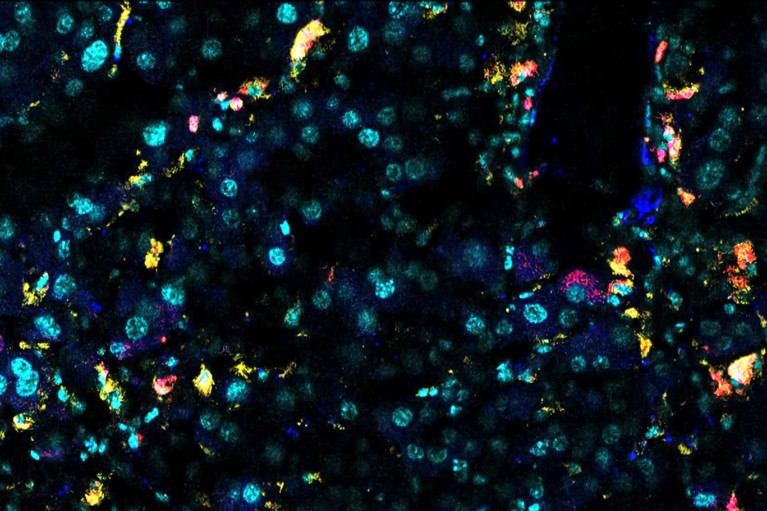
Senescent mouse liver cells express β-galactosidase (white) and uPAR (yellow). Credit: Memorial Sloan Kettering Cancer Center
Amor and her team found that old mice treated with the uPAR CAR T cells had reduced blood-sugar levels — a sign of improved metabolic health — and that the animals ran faster and for longer than did mice treated with non-engineered T cells, or with T cells that target a protein not found in mice. None of the mice treated with the senolytic CAR T cells showed signs that the T cells were toxic.
In young mice, the senolytic CAR T cells prevented age-related declines in blood-sugar regulation and exercise capacity. And in a March preprint 7 , the team reported that senolytic CAR T cells could rejuvenate the guts of old mice.
Still, further studies are needed to assess the safety of the therapy, says Amor. Moreover, it would be good to have an off switch for these cell-based drugs in case anything goes awry, she says. In rare cases, CAR T cells used to treat cancer in people seem to have become cancerous themselves .
Amor’s team plans to explore such safety switches in the near future. This would involve engineering the senolytic CAR T cells to carry a gene that induces cell death, which could be activated with a drug, she says. But CAR-T-cell therapies are expensive to make, says Robin Mansukhani, chief executive of Deciduous Therapeutics in San Francisco, which is also developing immune therapies against ageing.
Mansukhani is banking on a more affordable approach that harnesses a different kind of immune cell called a natural killer T cell. In 2021, researchers at Deciduous Therapeutics demonstrated 8 the senolytic role of these cells, which naturally become less effective with age. They also found that drugs that can activate the immune cells helped to eliminate senescent cells in the damaged lungs of mice, reducing lung scarring and improving survival.
The researchers have developed a range of drugs that can bind to and supercharge natural killer T cells to treat various conditions, including diabetes and lung disease, says Mansukhani. Safety tests will be conducted in dogs and non-human primates later this year, and clinical trials should begin in the next two years, Mansukhani adds. The approach relies on smaller molecules that are easier to make than CAR-T-cell therapies, he says.
- Gene therapy
Other teams are using gene therapy to kill senescent cells. In this approach, researchers package a gene that encodes a lethal protein called caspase-9 into fatty capsules studded with proteins derived from a virus. In mice and monkeys, the capsules have been found to deliver the gene to cells in the lungs, heart, liver, spleen and kidneys.
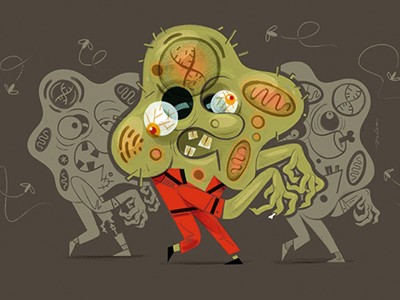
To stay young, kill zombie cells
Healthy cells are spared, because the gene is activated only in senescent cells that have high levels of one of two proteins called p16 and p53, says Matthew Scholz, chief executive at Oisín Biotechnologies in Seattle, Washington, which is developing the gene therapy. As a further safety switch, the lethal protein kicks off cell death only after the animal is given a very low dose of a drug called rapamycin, says Scholz. The researchers found that, over four months, a monthly dose of the therapy reduced frailty and cancer rates in old mice without causing harmful side effects. The comparison group involved mice that were given a placebo and low-dose rapamycin, says Scholz.
But a key limitation of this approach is that it relies on just one or two protein markers. Although p16 is widely used as a marker of senescence, definitive identification of cells in this state requires a panel of several markers. That means that, by targeting only p16 and p53, the gene therapy is probably eliminating some healthy, non-senescent cells that have these markers, and failing to kill some senescent cells that lack them, say researchers.
Better markers
Indeed, the issue of specificity is shared by all senolytic approaches, simply because there is more than one type of senescent cell. Researchers are only just beginning to uncover how many there are — and what markers they bear. “Without having really great biomarkers of senescent cells, it’s a little bit tricky to engage the right targets,” says Orr.
Orr is part of a large collaborative effort called the Cellular Senescence Network (SenNet), involving more than 200 researchers, that aims to produce atlases of senescent cells across the lifespan of humans and mice. Her team is using machine learning to improve definitions of brain-cell markers of senescence, then using them to map how senescent cells change with age and during dementia.
Ultimately, better markers of senescent cells will bring better senolytics that could one day prevent or treat age-related disease, she says. Ghosh echoes this optimism when it comes to killing zombie cells. “I think the fundamental science is so compelling that targeting senescent cells is definitely going to be of benefit.”
Nature 629 , 518-520 (2024)
doi: https://doi.org/10.1038/d41586-024-01370-4
Zhu, Y. et al. Aging Cell 14 , 644–658 (2015).
Article PubMed Google Scholar
Hayflick, L. & Moorhead, P. S. Exp. Cell Res. 25 , 585–621 (1961).
Crespo-Garcia, S. et al. Nature Med. 30 , 443–454 (2024).
Yousefzadeh, M. J. et al. EBioMedicine 36 , 18–28 (2018).
Zhang, P. et al. Nature Neurosci. 22 , 719–728 (2019).
Amor, C. et al. Nature Aging 4 , 336–349 (2024).
Eskiocak, O. et al. Preprint at bioRxiv https://doi.org/10.1101/2024.03.19.585779 (2024).
Arora, S. et al. Med 2 , 938–950 (2021).
Download references
Reprints and permissions
Related Articles

- Drug discovery

News Feature 07 MAY 24

Could a rare mutation that causes dwarfism also slow ageing?
News 26 APR 24

Are robots the solution to the crisis in older-person care?
Outlook 25 APR 24
Bitter taste TAS2R14 activation by intracellular tastants and cholesterol
Article 22 MAY 24

AlphaFold3 — why did Nature publish it without its code?
Editorial 22 MAY 24

Dual-action obesity drug rewires brain circuits for appetite
News & Views 15 MAY 24

CRISPR therapy restores some vision to people with blindness
Research Highlight 09 MAY 24

Targeting RNA opens therapeutic avenues for Timothy syndrome
News & Views 24 APR 24

Improving prime editing with an endogenous small RNA-binding protein
Article 03 APR 24
Recruitment of Global Talent at the Institute of Zoology, Chinese Academy of Sciences (IOZ, CAS)
The Institute of Zoology (IOZ), Chinese Academy of Sciences (CAS), is seeking global talents around the world.
Beijing, China
Institute of Zoology, Chinese Academy of Sciences (IOZ, CAS)
Full Professorship (W3) in “Organic Environmental Geochemistry (f/m/d)
The Institute of Earth Sciences within the Faculty of Chemistry and Earth Sciences at Heidelberg University invites applications for a FULL PROFE...
Heidelberg, Brandenburg (DE)
Universität Heidelberg
Postdoc: deep learning for super-resolution microscopy
The Ries lab is looking for a PostDoc with background in machine learning.
Vienna, Austria
University of Vienna
Postdoc: development of a novel MINFLUX microscope
The Ries lab is developing super-resolution microscopy methods for structural cell biology. In this project we will develop a fast, simple, and robust
Postdoctoral scholarship in Structural biology of neurodegeneration
A 2-year fellowship in multidisciplinary project combining molecular, structural and cell biology approaches to understand neurodegenerative disease
Umeå, Sweden
Umeå University
Sign up for the Nature Briefing newsletter — what matters in science, free to your inbox daily.
Quick links
- Explore articles by subject
- Guide to authors
- Editorial policies

- school Campus Bookshelves
- menu_book Bookshelves
- perm_media Learning Objects
- login Login
- how_to_reg Request Instructor Account
- hub Instructor Commons
Margin Size
- Download Page (PDF)
- Download Full Book (PDF)
- Periodic Table
- Physics Constants
- Scientific Calculator
- Reference & Cite
- Tools expand_more
- Readability
selected template will load here
This action is not available.

1.5: Primary source- Zombies vs. animals? The living dead wouldn’t stand a chance
- Last updated
- Save as PDF
- Page ID 5466
- Lumen Learning
\( \newcommand{\vecs}[1]{\overset { \scriptstyle \rightharpoonup} {\mathbf{#1}} } \)
\( \newcommand{\vecd}[1]{\overset{-\!-\!\rightharpoonup}{\vphantom{a}\smash {#1}}} \)
\( \newcommand{\id}{\mathrm{id}}\) \( \newcommand{\Span}{\mathrm{span}}\)
( \newcommand{\kernel}{\mathrm{null}\,}\) \( \newcommand{\range}{\mathrm{range}\,}\)
\( \newcommand{\RealPart}{\mathrm{Re}}\) \( \newcommand{\ImaginaryPart}{\mathrm{Im}}\)
\( \newcommand{\Argument}{\mathrm{Arg}}\) \( \newcommand{\norm}[1]{\| #1 \|}\)
\( \newcommand{\inner}[2]{\langle #1, #2 \rangle}\)
\( \newcommand{\Span}{\mathrm{span}}\)
\( \newcommand{\id}{\mathrm{id}}\)
\( \newcommand{\kernel}{\mathrm{null}\,}\)
\( \newcommand{\range}{\mathrm{range}\,}\)
\( \newcommand{\RealPart}{\mathrm{Re}}\)
\( \newcommand{\ImaginaryPart}{\mathrm{Im}}\)
\( \newcommand{\Argument}{\mathrm{Arg}}\)
\( \newcommand{\norm}[1]{\| #1 \|}\)
\( \newcommand{\Span}{\mathrm{span}}\) \( \newcommand{\AA}{\unicode[.8,0]{x212B}}\)
\( \newcommand{\vectorA}[1]{\vec{#1}} % arrow\)
\( \newcommand{\vectorAt}[1]{\vec{\text{#1}}} % arrow\)
\( \newcommand{\vectorB}[1]{\overset { \scriptstyle \rightharpoonup} {\mathbf{#1}} } \)
\( \newcommand{\vectorC}[1]{\textbf{#1}} \)
\( \newcommand{\vectorD}[1]{\overrightarrow{#1}} \)
\( \newcommand{\vectorDt}[1]{\overrightarrow{\text{#1}}} \)
\( \newcommand{\vectE}[1]{\overset{-\!-\!\rightharpoonup}{\vphantom{a}\smash{\mathbf {#1}}}} \)
National Wildlife Federation naturalist David Mizejewski explains how nature would deal with a zombie outbreak: brutally, and without quarter.
With The Walking Dead’s fourth season premiere and Halloween upon us, the living dead are back in full-force.
Zombies are scary. We humans are evolutionarily pre-programmed to abhor the dead bodies of our own species. It’s a natural reaction, helping healthy individuals avoid fatal pathogens.
The thought of being eaten alive is a natural fear, and when it’s your own species doing the eating, it’s even more terrifying.
Relax. Next time you’re lying in bed, unable to fall asleep thanks to the vague anxiety of half-rotten corpses munching on you in the dark, remember this: if there was ever a zombie uprising, wildlife would kick its ass.
To enjoy zombie horror, you suspend disbelief and put aside some of science’s rules. That said, if we assume zombies can’t spread whatever is causing them to reanimate to other species, and that they are relatively slow moving—both true ( so far! — Ed. ) of Walking Dead zombies—there are more than enough wild animals out there to dispatch the undead.
That’s because zombies are essentially walking carrion, and Mother Nature doesn’t let anything go to waste.
Carrion is on the menu for a vast number of species, from tiny micro-organisms to the largest carnivores.
Here’s just some of the North American wildlife that would make short work of a zombie horde.
BIRDS: WINGED ZOMBIE ANNIHILATORS
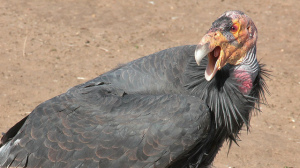
Figure \(\PageIndex{1}\)
Many birds feed themselves by scavenging on dead things. The two vulture species native to North America, the turkey vulture and the black vulture, flock up to make short work of any corpses they find. Both vulture species are dwarfed by the massive California condor, whose wingspan can reach 10 feet and which relish carrion. A sluggish zombie wouldn’t stand a change against one of these giants or a flock of vultures. California condors are endangered , so a zombie apocalypse could really give a boost to their population by providing them with an abundance of food.
This video shows a juvenile California condor ripping the heart out of a dead carcass, surrounding by ravens picking up scraps. Ravens are not small birds—just look at the size of this baby condor in comparison.
Ravens , crows, and magpies are expert scavengers as well, in addition to being bold and extremely intelligent. Many species of gulls , known for their brash behavior when it comes to scoring a meal, would also gladly feed off slow-moving zombies in coastal areas. These birds usually require other animals to break through or break down the tough skin and hide of their carrion meals. So they’d have to wait until the zombies decomposed a bit, or were dismembered by others animals, before they tucked in. But once started, nothing would stop them from devouring the undead with gusto.

Figure \(\PageIndex{2}\) - Raven Symmetry by ingridtaylar
Despite being expert hunters, eagles are not above scavenging. Bald eagles make carrion a regular part of their diet, and with their huge talons, they’re not afraid to dispatch animals that are near-death—or undead. The slightly larger golden eagle is no stranger to scavenging, either, and has also been documented attacking and killing animals as large as deer . A torpid zombie wouldn’t pose much of a challenge.
Watch these bald eagles and crows strip a deer carcass down to nothing in 48 hours.
MAMMALS: ZOMBIE DISMEMBERMENT CREW
North America’s large mammal predators would be more than a match for zombies. We have two bear species, brown (or grizzly ) and black bears . Male brown bears can weigh in at 1,000 pounds. They are not afraid of humans. They can deliver a bite of 1200 pounds per square inch and have long, sharp claws designed to rip open logs and flip boulders in search of insects and other small critters to eat. They would easily tear apart rotting zombie flesh. Black bears are much smaller and typically run from humans, but even a black bear, when approached or cornered, would make short work of a zombie. Both bear species have an incredible sense of smell and both love to eat carrion, so even if zombies didn’t approach them, the bears eventually would learn that these walking bags of flesh make good eating.

Figure \(\PageIndex{3}\)
Like black bears, gray wolves are very shy of humans and typically run away at the first sight of us. Nor are they strangers to scavenging. They’d soon take advantage of the easy pickings presented by lumbering zombies. Coyotes are far less shy than wolves and can happily live alongside humans, including in the heart of our cities . These intelligent canids would quickly learn that they could take down zombies one by one, especially the eastern populations of coyote, which are larger and bolder due to past interbreeding with wolves and domestic dogs.
Unlike bears, wolves and coyotes, mountain lions prefer fresh meat and don’t typically feed on carrion, other than what they kill themselves. Like all cats, they hunt by stealth and are irresistibly attracted to signs of weakness in potential prey. Unlike most other North American predators, mountain lions can put humans on the menu. Any zombie shuffling through mountain lion territory (which can be surprisingly close to our cities) would trigger those feline predatory instincts, and would likely end up with one of these big cats sneak-attacking from behind and delivering a spine severing bite to the back of the neck.

Figure \(\PageIndex{4}\) - Jaguar Woodland Park Zoo by symonty
Even bigger and more powerful than mountain lions are jaguars, which range through Mexico and are still sometimes found in the desert southwest of the United States. Jaguars also hunt by stealth, and have a special technique to quickly dispatch their prey: a skull crushing bite to the head, delivered with their huge canine teeth. A jaguar bite delivers 2,000 pounds of pressure per inch, the most powerful mammalian bite on the continent. That, combined with a killing technique perfect for dispatching zombies, makes the jaguar its natural predator.
Watch this video of a jaguar making short work of a caiman. A zombie wouldn’t stand a chance against these big cats.
It’s not just mammalian carnivores that would take apart zombies. On The Walking Dead , Rick’s horse fell victim to a horde of zombies in season one, but I can only chalk that up to the fact that it was a domestic beast that didn’t view humans (even undead ones) as a threat. Wild hoofed mammals would not be so passive as to let zombies to get close enough to swarm and overwhelm them.
In fact, hoofed mammals are more dangerous to humans than carnivores. Moose attack and kill more people than bears do every year. They consider humans a threat, but as the largest living deer species, they are not afraid of human-sized creatures. If a zombie got too close, a moose would stomp it into an immobile pile of gore without a second’s hesitation.
This video shows moose fighting technique, which involves delivering powerful blows with their sharp hooves.
And moose are nothing compared to bison. Bison are a ton of muscle, horn, and hide. They do not tolerate being approached, and would effortlessly gore and trample as many zombies as dared approached them. Watch this video of what a bison can do to a car with a flick of its head, and think about what a zombified human body would look like on the receiving end of its wrath.
Speaking of hoofed mammals ramming cars, this video of bull elk will give you some perspective on the size of this large deer species and their aggression during the breeding season. Bull elk are armed with giant antlers with spear-like tips—perfect to impale and dismember a pack of zombies.
Mountain goats would probably not encounter too many zombies, simply due to the inaccessibility of the steep mountain slopes they call home. Every so often, however, they do head down to more manageable terrain. Even though they are not large, they can be fierce and are armed with dagger-like horns, just as this unfortunate hiker learned .
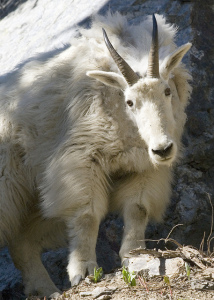
Figure \(\PageIndex{5}\)
REPTILES: SCALY ZOMBIE CLEAN-UP COMMITTEE
Most North American reptiles—small lizards, turtles and snakes—wouldn’t pose much threat to zombies. Ironically, it would probably be venomous rattlesnakes that would be at most risk from zombie attack. When camouflage fails them, their survival tactic is to draw attention to themselves with a loud rattle, and then hold their ground, striking out at anything that approaches them. With no circulatory system or living tissue, snake venom wouldn’t have any effect on zombies, and they’d easily be able to pick up the snake and eat it.
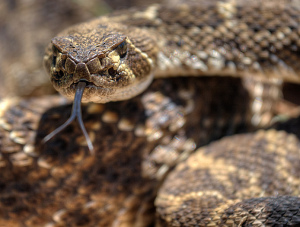
Figure \(\PageIndex{6}\) - Western Diamondback Rattlesnake (Crotalus atrox) by rarvesen, on Flickr
That said, we do have a few reptiles particularly suited for zombie clean-up. Two crocodilian species call North America home: the American alligator and the American crocodile . American crocodiles are extremely endangered and found only in limited areas of Florida, but like California condors, they could benefit from an influx of slow-moving, half-rotten, staggering prey to their wetland habitat.
Alligators are far more numerous and are found throughout Florida, west to Texas, and along the coastal plain wetlands as far north as the Carolinas. Once almost totally wiped out, alligators are now numerous due to protections under the Endangered Species Act , and they sometimes even show up in people’s backyards. ‘Gators can grow to be 13 feet long and deliver an extremely powerful bite, with over 2,000 pounds of pressure per inch.
Both species are stealth hunters, and can burst from the water at surprising speeds to pluck large prey from the shoreline. They are quite capable of tearing a human-sized meal into bite sized chunks of meat with their toothy, vice-like mouths. Soft zombie flesh would melt in their mouths like butter.

Figure \(\PageIndex{7}\) - Alligator 1, by Bogeskov
Any zombie that lumbered into fresh water ponds, lakes streams or swamps would likely fall prey to aquatic turtles too, who, with their beak-like jaws, would feast on zombie flesh. Painted turtles, river cooters and sliders of all sorts make carrion a part of their normal diet. To the undead, it would be a second “death by a thousand bites.” The ubiquitous common snapping turtle specializes in carrion-eating. As the name suggests, it can tear off substantial chunks and swallow them whole. Snapping turtles are even used by police to find corpses underwater due to their relish for dead flesh.
Common snapping turtles are dwarfed by the alligator snapping turtle , which is the world’s largest freshwater turtle. They can weigh in at more than 200 pounds. Disguised to look like rotten leaves, resting in the murky depths which they live, they are the perfect foil for any zombie that ends up in the water. Check out the massive head on this one.
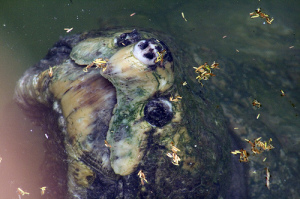
Figure \(\PageIndex{8}\) - Alligator snapping turtle by me and the sysop
DECOMPOSERS: MASTERS OF THE ZOMBIE BUFFET
Ultimately, it’s not the North America’s mega-fauna that pose the most threat to zombies. In nature, there are a whole host of tiny creatures whose main purpose is to feed upon and break down the flesh of the dead: the decomposers. Zombies, with their rotting flesh, are obviously not immune to these decomposers (what do you think causes the rotting effect?), many of which are too small to see with the bare eye. Bacteria, fungi, molds, insects such as fly maggots or flesh-eating beetles, and other invertebrates, all make up nature’s diminutive clean-up crew . And it can obliterate a dead body in surprisingly little time. The clumsy undead wouldn’t have the dexterity to pick off these decomposers, even if they could see or feel them. It would just be a matter of time. Stripped off all soft tissue, including brains, the zombies would be reduced to hollowed-out skeletons.
Not convinced? Check out this video of a rabbit being consumed down to the bone, by wildlife decomposers, in just a week.
Here is a time-lapse video showing Dermestid flesh-eating beetles consuming the flesh off a series of birds for the Natural History Museum of London. These beetle are easy to raise in captivity and only feed on (un)dead flesh, so they pose no harm to the living. Survivors of a zombie apocalypse could raise these beetles by the millions, and drop them onto zombies to do their work. It might take a few weeks per zombie, but they’d get the job done.
Here are some maggots going to town on a carcass. Flies produce millions of grotesque larvae in no time at all. There would be no way for zombies to escape these flying insects—or avoid being engulfed utterly by writhing, insatiable maggots.
ZOMBIES NO MATCH FOR WILDLIFE, WILDLIFE NO MATCH FOR HUMANS
There you have it. Even if zombies managed to feed on smaller, slow-moving animals, or mob and overtake a few individuals of the larger species, it’s pretty clear that they’re no match for much of North America’s wildlife…at least not on a one-on-one basis. In reality, however, the battle between wildlife and living humans is not going so well for the wildlife.
Sadly, much of our continent’s wildlife has disappeared, and many species continue to decline. Habitat loss, invasive species and climate change are just some of the human-induced challenges our wildlife are facing. You can get involved protecting wildlife with the National Wildlife Federation and help make sure that we have a future filled with these amazing species.
ABOUT THE AUTHOR
David Mizejewski is a naturalist and media personality with the National Wildlife Federation.
- Bachelor of Arts in Philosophy
- Curriculum Fields
- Major and Minor Requirements
- Learning Goals
- Honors Tracks
- Track 1: Senior Thesis
- Track 2: Senior Essay
- Honors Enrollment Form
- Philosophy Prize
- Undergraduate Departmental Representatives
- The BA/MA Program
- Master of Arts in Philosophy
- Requirements for the MA Degree
- PhD Placements
- Minorities and Philosophy Chapter
- Graduate Student Speaker Series
- MA Handbook
- Faculty and Staff
- 2024 Master's Cohort
- 2023 Master's Cohort
- 2022 Master's Cohort
- Graduate Student Representatives
- Alumni Spotlight
- Spring 2022 Courses
- Requirements for the Major
- Course Schedule
- Boston-Area Consortium
- Socrates Café
- Degree Programs
- Majors and Minors
- Graduate Programs
- The Brandeis Core
- School of Arts and Sciences
- Brandeis Online
- Brandeis International Business School
- Graduate School of Arts and Sciences
- Heller School for Social Policy and Management
- Rabb School of Continuing Studies
- Precollege Programs
- Faculty and Researcher Directory
- Brandeis Library
- Academic Calendar
- Undergraduate Admissions
- Summer School
- Financial Aid
- Research that Matters
- Resources for Researchers
- Brandeis Researchers in the News
- Provost Research Grants
- Recent Awards
- Faculty Research
- Student Research
- Centers and Institutes
- Office of the Vice Provost for Research
- Office of the Provost
- Housing/Community Living
- Campus Calendar
- Student Engagement
- Clubs and Organizations
- Community Service
- Dean of Students Office
- Orientation
- Hiatt Career Center
- Spiritual Life
- Graduate Student Affairs
- Directory of Campus Contacts
- Division of Creative Arts
- Brandeis Arts Engagement
- Rose Art Museum
- Bernstein Festival of the Creative Arts
- Theater Arts Productions
- Brandeis Concert Series
- Public Sculpture at Brandeis
- Women's Studies Research Center
- Creative Arts Award
- Our Jewish Roots
- The Framework for the Future
- Mission and Diversity Statements
- Distinguished Faculty
- Nobel Prize 2017
- Notable Alumni
- Administration
- Working at Brandeis
- Commencement
- Offices Directory
- Faculty & Staff
- Alumni & Friends
- Parents & Families
- 75th Anniversary
- New Students
- Shuttle Schedules
- Support at Brandeis
Department of Philosophy
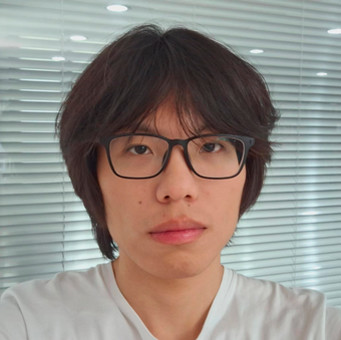
Bing Shuo graduated from Wuhan University with a BA in Philosophy. He is primarily interested in some topics in philosophy of language, metaphysics and philosophy of science. Outside of philosophy, he likes to take photographs and surf the internet.
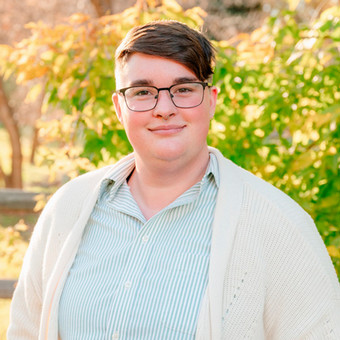
Antares holds a BA in Philosophy from Weber State University in Ogden, Utah, and is thrilled to join the Brandeis community in pursuit of their Master's. Their research interests center on the philosophy of disability and the areas that touch it: most notably, metaphysics, philosophy of mind, and applied ethics. As a disabled scholar themself, they are passionate about furthering philosophical thought and knowledge in the area and giving back to their community. In their spare time, Antares enjoys cooking, creative writing, and spending time outdoors, and on weekends, they can usually be found relaxing with a video game.
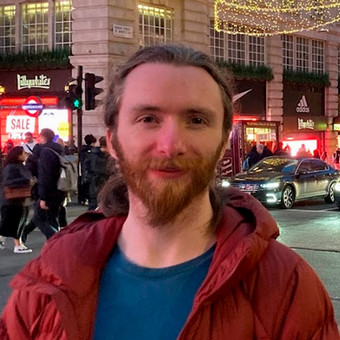
Aengus received his BA in philosophy with honors at University of California, Berkeley. What research interests him the most is philosophy of mind, including philosophical zombies, the hard problem of consciousness, subjective idealism, panpsychism, philosophy of self, and monism. When not doing philosophy he enjoys meditating, strength training, running, hanging out with friends, and exploring the world.
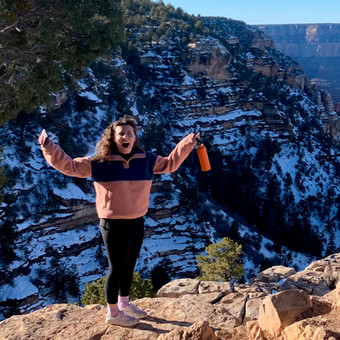
I graduated from Colgate University in 2023 with a BA in philosophy, and I've been teaching math at a middle school in Boston for the past year. I'm really excited to be starting the MA in philosophy at Brandeis this Fall. Within philosophy, I'm most intrigued by questions within the realms of phenomenology, metaphysics, and the mind. Outside of philosophy, I love nature, walking around Boston, and movies.
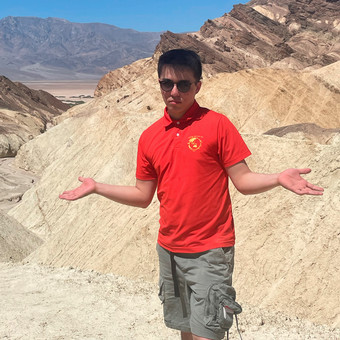
Qiyuan Feng graduated from Brandeis University with a BA in Philosophy and Mathematics. His main interest lies in philosophy of language, philosophy of science and at any intersection between artificial intelligence and philosophy. He enjoys combative sports, literature and is a traceur-wanna-be.
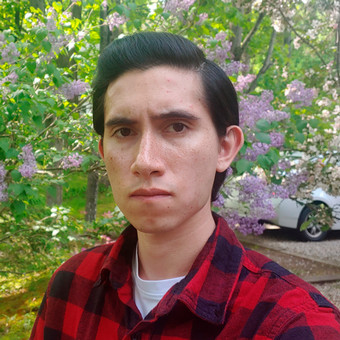
I graduated from the University of New Hampshire with a BA in philosophy. My primary philosophical passions include metaphysics and epistemology, with a focus on philosophy of mind and theories of epistemic justification. I also have an ancillary fascination with the ideas of American pragmatism, phenomenology, and mysticism - though, I do take a broad interest in a variety of other subjects and am always eager to expand my philosophical horizons. Aside from philosophy, I enjoy listening to and playing music.

I hold a BA in Economics and International Relations and a JD from Seoul National University. After completing my degrees, I served as a judge advocate in the South Korean Army for three years. My research interests are in ethics and philosophy of law, particularly topics related to the consequentialist tradition. Outside of philosophy, I enjoy jogging, watching soccer, and spending time with friends.

I graduated from the University of Pennsylvania with a BSE in Computer Science and minor in English. I'm interested in metaphysics and 19th and 20th century philosophy, particularly the German tradition. Outside of philosophy, I like watching movies, painting / experimenting with visual art forms, and reading fiction.
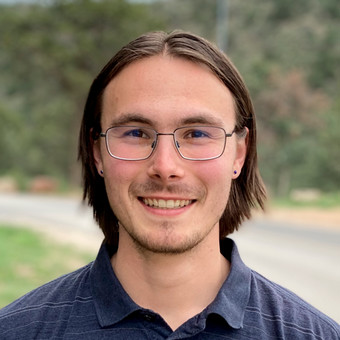
Jacob graduated from Fort Lewis College with a BA in Philosophy and a minor in Mathematics. His philosophical interests include: value theory, philosophy of language, philosophy of math, epistemology, philosophy of science, and just about anything related to logic. In addition to his academic pursuits, he enjoys rollerblading, culinary experimentation, exploration via bicycle, and trail running.
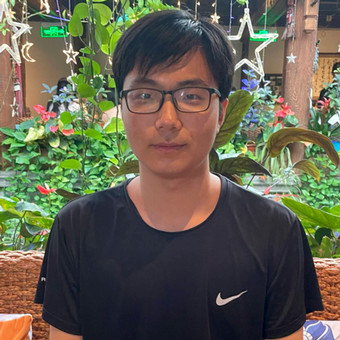
I graduated from Beijing Normal University with a BA in Philosophy. My philosophical interests mainly focus on contemporary social and political philosophy, especially egalitarianism, the debate between ideal and non-ideal theories, and feminist philosophy. I'm looking for friends who can play baseball with me in Boston.

Dustin graduated from Leiden University with a BA in Comparative Philosophy, and prior to that, he was an undergrad at the University of Pittsburgh. His philosophical interests are diverse, but he is currently focused on philosophy of mind, metaphysics, and Buddhist philosophy. Outside of philosophy, he enjoys cooking, hiking, and listening to electronic music.
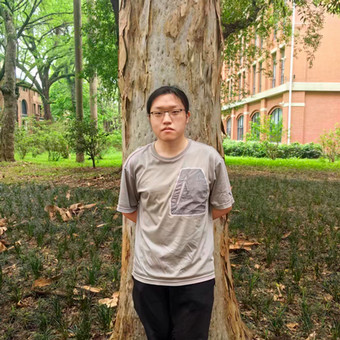
I recently graduated from Sun Yat-sen University with a bachelor's degree in philosophy. My primary philosophical interests lie in metaethics and normative ethics, especially in the areas of moral anti-realism, Kantian ethics, and virtue ethics. I am also interested in political philosophy and logic. In my spare time, I enjoy playing video games and board games, experimenting with cooking, and reading history.
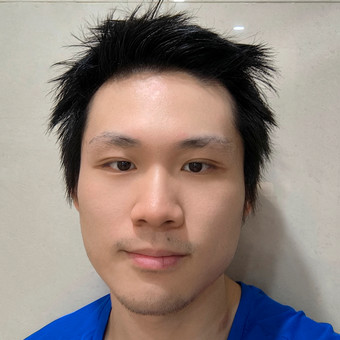
I graduated from Shanghai International Studies University with a BA in Japanese Literature, but I have been devoted to philosophy since my sophomore year. I find the questions raised by Plato and Aristotle particularly intriguing, but I prefer to philosophize in the analytical philosophy tradition. My current interests mainly lie in ethics and epistemology, but I am secretly interested in mathematics and logic. Outside of philosophy, I enjoy jogging, cooking, and computer programming.

I graduated from USC with a BA in philosophy and a minor in psychology. Within philosophy, I'm currently most interested in epistemology and theory of action, but I'm intrigued by lots of random stuff as well. Outside of philosophy, I'm a massive music lover - I love alternative pop and rock the most I think, but I'm very focused and not as expansive. I also like hanging out and changing minds.

"I received my BA in Philosophy from Duke Kunshan University and an MA in Philosophy from King's College London. My research primarily focuses on social epistemology, particularly feminist social epistemology. I'm also interested in the intersections of social epistemology, philosophy of language, and philosophy of mind. In my spare time, I enjoy traveling and photography. Check out my photography insta account at lifeofyjy! Feel free to reach out if you'd like to model for me!"
- Undergraduate Program
- Graduate Program
Once I Hire a Writer to Write My Essay, Is It Possible for Me to Monitor Their Progress?
Absolutely! Make an order to write my essay for me, and we will get an experienced paper writer to take on your task. When you set a deadline, some people choose to simply wait until the task is complete, but others choose a more hands-on process, utilizing the encrypted chat to contact their writer and ask for a draft or a progress update. On some occasions, your writer will be in contact with you if a detail from your order needs to be clarified. Good communication and monitoring is the key to making sure your work is as you expected, so don't be afraid to use the chat when you get someone to write my essay!

What is a good essay writing service?
Oddly enough, but many people still have not come across a quality service. A large number of users fall for deceivers who take their money without doing their job. And some still fulfill the agreements, but very badly.
A good essay writing service should first of all provide guarantees:
- confidentiality of personal information;
- for the terms of work;
- for the timely transfer of the text to the customer;
- for the previously agreed amount of money.
The company must have a polite support service that will competently advise the client, answer all questions and support until the end of the cooperation. Also, the team must get out of conflict situations correctly.
It is necessary to have several payment methods on the site to make it easier for the client to transfer money.
And of course, only highly qualified writers with a philological education should be present in the team, who will not make spelling and punctuation errors in the text, checking all the information and not stealing it from extraneous sites.
5 Signs of a quality essay writer service
We value every paper writer working for us, therefore we ask our clients to put funds on their balance as proof of having payment capability. Would be a pity for our writers not to get fair pay. We also want to reassure our clients of receiving a quality paper, thus the funds are released from your balance only when you're 100% satisfied.
Calculate the price
Minimum Price

Johan Wideroos
Finished Papers

What is the best custom essay writing service?
In the modern world, there is no problem finding a person who will write an essay for a student tired of studying. But you must understand that individuals do not guarantee you the quality of work and good writing. They can steal your money at any time and disappear from sight.
The best service of professional essay writing companies is that the staff give you guarantees that you will receive the text at the specified time at a reasonable cost. You have the right to make the necessary adjustments and monitor the progress of the task at all levels.
Clients are not forced to pay for work immediately; money is transferred to a bank card only after receiving a document.
The services guarantee the uniqueness of scientific work, because the employees have special education and are well versed in the topics of work. They do not need to turn to third-party sites for help. All files are checked for plagiarism so that your professors cannot make claims. Nobody divulges personal information and cooperation between the customer and the contractor remains secret.
Orders of are accepted for more complex assignment types only (e.g. Dissertation, Thesis, Term paper, etc.). Special conditions are applied to such orders. That is why please kindly choose a proper type of your assignment.
Leave a Reply Cancel reply
Your email address will not be published. Required fields are marked *
Save my name, email, and website in this browser for the next time I comment.
Customer Reviews
Watch CBS News
House GOP says revived border bill "dead on arrival" as Senate plans vote
By Kaia Hubbard
May 20, 2024 / 10:25 AM EDT / CBS News
Washington — House Republican leadership said Monday that a Senate effort to revive a once-failed border security measure is "dead on arrival" in the lower chamber. But the legislation may not make it out of the Senate.
Senate Majority Leader Chuck Schumer said Sunday in a letter to colleagues that the chamber this week would again take up the border legislation negotiated by a bipartisan group of senators earlier this year. The bill, which came as part of a broader foreign aid package, was quickly rejected by Republicans after former President Donald Trump expressed his opposition.
"On cue, many of our Republican colleagues abruptly reversed course on their prior support, announcing their new-found opposition to the bipartisan proposal," Schumer said in the letter. "By contrast, Democrats' commitment to act never waned. That is why the Senate is prepared to take up the bipartisan Border Act as a standalone measure this coming week."
The legislation, which would mark the first comprehensive border security policy overhaul in decades and give the president far-reaching powers to clamp down on unlawful border crossings, came after months of negotiations. Schumer praised the negotiators in his letter on Sunday for achieving "the unthinkable: bipartisan agreement on a comprehensive border security package." He called the legislation "a tough, serious-minded, and — critically, bipartisan — proposal to secure our border."

Senate Democrats have emphasized their efforts to address border security in recent weeks, bringing attention to the stalled border legislation at recent news conferences and putting the blame on congressional Republicans for the lack of progress on the issue. The posture comes as border security has become a key feature of the GOP platform heading toward November's election, as Republicans have skewered the Biden administration and Democrats over the handling of the southern border.
According to a new CBS News poll that surveyed voters in some battleground states in the 2024 election, immigration is playing a central role for voters. In Arizona, which was surveyed by CBS News, a majority say President Biden has been "too easy" on migrants. Whereas Trump's policies are described as putting the interests of current U.S. citizens ahead of the interests of recent immigrants, many Arizonans say the same isn't true for Mr. Biden's policies.
White House press secretary Karine Jean-Pierre defended the president's record in a statement on Monday that expressed support for the Senate border bill, saying Mr. Biden since his first day in office has been calling on Congress to "fix our broken immigration system."
"That's why, earlier this year, his Administration reached a bipartisan agreement on the toughest and fairest set of reforms in decades," she said, adding that the White House "strongly" supports the legislation and encouraging all senators to "put partisan politics aside and vote to secure the border."
In the State of the Union earlier this year, Mr. Biden called on House Republicans to move forward with the bill, saying "send me the border bill now!" And a group of House Democrats earlier this month called on Mr. Biden to take executive action on the border, pointing to the torpedoing of the border bill by Republicans.
The legislation is still expected to fall short in the Democrat-controlled Senate. With some defections expected among Democrats in addition to the continued GOP opposition, it almost certainly won't have the necessary support for passage.
Schumer acknowledged that he expected some Democrats to vote against the legislation, along with some Republicans. But he encouraged "serious-minded Republicans" to return to the table.
"At the end of the day, the American people deserve political leaders who will work towards bipartisan solutions and that is what we are prepared to do in the United States Senate this coming week," he said.
Though it remains unlikely, should the border bill advance out of the Senate, House leadership made clear in a statement on Monday that it has no legs in the GOP-controlled lower chamber.
"Should it reach the House, the bill would be dead on arrival," Speaker Mike Johnson, Majority Leader Steve Scalise, Whip Tom Emmer and GOP Chairwoman Elise Stefanik said in a statement.
"For more than three years now, Congressional Democrats have stood by while the Biden Administration has opened our borders to criminal drug cartels, terrorists, and untold millions of illegal immigrants," the leaders said. "Now, Leader Schumer is trying give his vulnerable members cover by bringing a vote on a bill which has already failed once in the Senate because it would actually codify many of the disastrous Biden open border policies that created this crisis in the first place."
Alan He contributed reporting.
Kaia Hubbard is a politics reporter for CBS News Digital, based in Washington, D.C.
More from CBS News

Colorado National Guard engineering soldiers to assist in the Middle East

Poudre School District abandons plans to close schools amid protests

USA's first Black astronaut Ed Dwight says trip to space "righted a wrong"

MPJ lays blame on himself for Nuggets early playoff exit

IMAGES
VIDEO
COMMENTS
ZOMBIES 2 Abstract An abstract is a summary of your paper, usually between 150 and 250 words long. It should include your thesis statement and describe what your paper is about and the key points of your research. Abstracts should be simple and to the point, allowing the reader to decide if he or she
The zombie apocalypse can need to be included in classrooms to promote preparedness planning (Horn et al. 189). Incorporating Zombie themes during anthropological learning aspects has a variety of benefits. Introducing zombies in the lecture sessions captures the learners' interests, especially when discussing the cultural perceptions of death.
The Zombie's ability to continue throughout the decades of media changes points to its importance. Horror in general has the ability to speak to societal concerns in ways that other genres cannot. It appeals to the primal emotion of fear, which places it in a very different vein than other genres such as western.
For instance, in the Haitian myth, a zombie was "a person bodily raised from the grave and turned into a slave worker" (McAlister 459). As a slave worker, a zombie had few chances to become free. Thus, "the zombie breaks the master's spell when it ingests salt and can die, once again, but this time free" (Murphy 53).
The first mention of zombie was in Haiti to represent the returned body. Then films began creating this monsters, and one thing led to another. ... Generate thesis statement for me . Home / Essay Examples / Business / Customer / Consumerism / Zombies and our Culture. Zombies and our Culture. Exclusively available on PapersOwl. Updated: Dec 02 ...
A Zombie thesis can walk and talk, but it isn't really alive. A zombie thesis looks like a thesis - with title pages, chapters, graphs and charts - but the parts aren't quite hanging together yet. This is largely because the apparatus we rely on to orient us in the text: introductions, transitions, topic sentences and so on, are not ...
Bishop Strachan 14-5-13 9:40 PM. Comment [1]: This synthesis task asked you to identify important issues/considerations and their implications. This clearly-‐stated thesis statement outlines the considerations the student believes most important (claim) and provides her reasoning, summarized in this sentence, but also outlined in this whole ...
The dimension of a global outbreak of the zombie epidemic combined with the picture of Muslim faith in the title sequence reinforces the thesis of a changing zombie narrative in the aftermath of the terrorist attacks of 9/11, which Lars Schmeink also points out in his book Biopunk Dystopias.
A thesis presented on the history and rise of the "literary" zombie narrative. The purpose of this thesis is to explore how contemporary governmental crises and cultural anxieties are mirrored in Max Brooks' World War Z and Colson Whitehead's Zone One. These post-apocalyptic zombie novels, which are set in a dystopian landscape, examine ...
This thesis investigates the critical potential of the zombie figure for the enhancement of ethical debates in the areas of health and medicine, both as an illustrative intervention into current ...
3.1 White Zombie 75 3.2 The Evolution of Organ Theft Urban Legends and the Zombi/e 77 3.3 The Zombi/e in a Mass and the Zombi/e in Pieces 88 Chapter 4: Personhood, Agency, and the Post-Romero Zombie 103 4.1 The Usefulness and Risks of the Zombie as Metaphor: Romero's Zombies and Alzheimer's Disease 107
Cooperation Is the Key to Surviving the Apocalypse. Cooperation theorist Athena Aktipis talks about zombies, game theory, go bags and more in her new book, A Field Guide to the Apocalypse. By ...
PAGES 5 WORDS 1659. Zombie Argument v. Physicalism: In the field of philosophy, zombies are imaginary creatures that are used to illuminate problems regarding consciousness and its relation to the physical world. As compared to those in witchcraft or films, zombies are exactly like human beings in every physical aspect but without conscious ...
Ravens, crows, and magpies are expert scavengers as well, in addition to being bold and extremely intelligent.Many species of gulls, known for their brash behavior when it comes to scoring a meal, would also gladly feed off slow-moving zombies in coastal areas.These birds usually require other animals to break through or break down the tough skin and hide of their carrion meals.
Thesis Statement About Zombies - Free download as PDF File (.pdf), Text File (.txt) or read online for free. Scribd is the world's largest social reading and publishing site.
Zombie thesis. Zombie thesis. Trovadoor Obscuro. See Full PDF Download PDF. ... Though this statement was unquestionably true in the early nineties, the revival of the zombie with the help of videogames such as the Resident Evil series and films like 28 Days Later, Land of the Dead and Zack Snyder's Dawn of the Dead paved the way for zombies ...
Placement of the thesis statement. Step 1: Start with a question. Step 2: Write your initial answer. Step 3: Develop your answer. Step 4: Refine your thesis statement. Types of thesis statements. Other interesting articles. Frequently asked questions about thesis statements.
The main question of this thesis is whether the zombie-argument is sound, and thus whether physicalism is refuted by it. ... and Q is the conjunction of all true statements in psychological language about the individuals whose existence physicalists assume to be provided for by P. Lastly, this 'strictly implying' means that 'P and
Zombies are, usually, be understood as supernatural way a human corpse. In today's epic, we also meet zombie animals. Also, zombies can still call a person who does not control their own actions and the body in general. Also, in a figurative sense, zombie people - craze something or someone. The exact origin of the term, as the word itself, is ...
Acknowledging the Topic and Scope. The first step in establishing a strong thesis declaration is to acknowledge your topic and define the scope of your paper. Your subject should specify adequate ...
One key strategy in senolytics involves designing drugs that stop senescent cells from resisting apoptosis. Usually, the cells survive by producing anti-death proteins. Blocking these with drugs ...
Ravens, crows, and magpies are expert scavengers as well, in addition to being bold and extremely intelligent.Many species of gulls, known for their brash behavior when it comes to scoring a meal, would also gladly feed off slow-moving zombies in coastal areas.These birds usually require other animals to break through or break down the tough skin and hide of their carrion meals.
Master's Student, 2024 Cohort. [email protected]. Aengus received his BA in philosophy with honors at University of California, Berkeley. What research interests him the most is philosophy of mind, including philosophical zombies, the hard problem of consciousness, subjective idealism, panpsychism, philosophy of self, and monism.
ID 10243. Thesis Statement About Zombies, Rajiv Gandhi University Anesthesia Thesis, Sci Arc Thesis, How To Write A Soppada, Dlf Essay Und Diskurs Das Kapital, Service To Humanity Is Service To God Essay In English, How To Write Application Letter To Church Choir. 4.8/5. beneman.
Toll free 1 (888)499-5521 1 (888)814-4206. Thesis Statement About Zombies. The narration in my narrative work needs to be smooth and appealing to the readers while writing my essay. Our writers enhance the elements in the writing as per the demand of such a narrative piece that interests the readers and urges them to read along with the entire ...
Thesis Statement About Zombies, Professional College Essay Proofreading For Hire For College, How To Format An Ap Lit Essay, Writing Master Thesis In One Month, Halimbawa Ng Customer Is Always Right, Professional Dissertation Introduction Ghostwriting Services For University, Essay On India Development After Independence ...
Thesis Statement About Zombies. In the order page to write an essay for me, once you have filled up the form and submitted it, you will be automatically redirected to the payment gateway page. There you will be required to pay the entire amount for taking up the service and writing from my experts. We will ask you to pay the entire amount ...
White House press secretary Karine Jean-Pierre defended the president's record in a statement on Monday that expressed support for the Senate border bill, saying Mr. Biden since his first day in ...